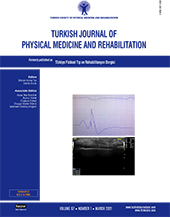Proximal muscle strength as a predictor of vitamin D insufficiency in elderly
2 Department of Physical Medicine and Rehabilitation, Division of Rheumatology, Çukurova University Faculty of Medicine, Adana, Turkey DOI : 10.5606/tftrd.2021.5323 Objectives: This study aims to evaluate the association of serum vitamin D level with proximal muscle strength, tone, elasticity, and stiffness in elderly.
Patients and methods: Between September 2017 and January 2018, a total of 109 participants (21 males, 88 females; mean age: 71.2±4.6 years; range, 65 to 85 years) were included in the study. The proximal muscle strength was evaluated by MicroFET® 3 device. The muscle tone, elasticity, and stiffness were measured using the MyotonPRO® digital palpation device. Serum 25-hydroxyvitamin D [25(OH)D] level was tested by high-performance liquid chromatography. A receiver operating characteristic (ROC) curve was performed to evaluate the potential role of MicroFET® 3-measured proximal muscle strength in the quantification of vitamin D status.
Results: Vitamin D sufficient participants had a higher proximal muscle strength (p<0.001). Quadriceps and hamstring elasticity at the non-dominant site were significantly higher in vitamin D sufficient group (p<0.05). The ROC analysis indicated that the deltoid muscle strength had the potential of determining vitamin D insufficiency with moderate accuracy (area under the curve=0.744; 95% confidence interval: 0.643-0.845; p<0.001).
Conclusion: Proximal muscle strength, elasticity, and physical performance are associated with vitamin D status. Proximal muscle strength measured by a hand-held dynamometer can be used as a predictor of hypovitaminosis D in elderly.
Keywords : Geriatrics, gerontology, muscle strength, muscle tension, muscle tone, vitamin D

















